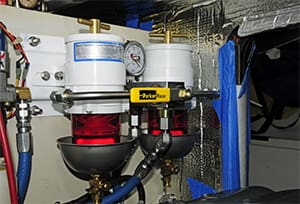The mission of a primary fuel filter is to capture, separate and store contaminants, be they biological, asphalt or water based. Toward that end, the most effective primary filters typically possess some or all of the following attributes:
• They must be easy to service, preferably without using tools.
• The filter elements must be readily available and also easy to replace, and they should be designed to repel or block water molecules.
• They should possess ample capacity for retaining water (at least a quart) and they should be capable of being equipped with a water sensor probe/alarm.
• Removal of air at the time of element replacement should also be relatively easy.
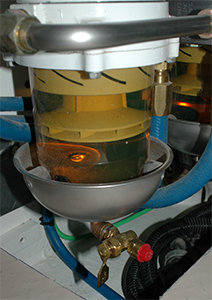 |
|
Drain valves allow easy water removal. This valve is correct; it turns through 90° and is UL listed. |
The ideal filter should also have the option of accepting a vacuum gauge so the degree of filter element contamination can be ascertained. Although it makes for an easy installation, avoid the temptation to install the vacuum gauge in place of the filter’s servicing T-handle; doing so negates the first important attribute of easy tool-free service. A clear sight bowl will make it easy to determine, at a glance, if debris or water has accumulated (the sight bowl should be equipped with a metal heat shield — see sidebar). Finally, the accumulation bowl must be equipped with a large-diameter, clog-resistant, metal drain valve, which must be situated so that it is accessible and drained liquid is easily captured. The drain should be equipped with a plug, which serves as a second line of defense against leaks in the event the valve is opened inadvertently.
It’s no accident that the above-listed attributes accurately describe a Racor MA Turbine series fuel filter. The “MA” suffix and the blue label denote Racor’s marine application, and although they are typically marginally less expensive, avoid using the automotive version of these filters, which carry an FG or FH suffix — they lack metal drains and heat shields.
There’s a reason Racor fuel filters have seemingly cornered the marine fuel filtration market: They work exceptionally well and are easy to service. Racor filters use a turbine-like design to spin free water out of fuel using centrifugal force, while a conical baffle arrangement enhances coalescing and separation of smaller entrained water droplets. Finally, the media used for the Racor Aquabloc replaceable elements are treated to resist the passage of water.
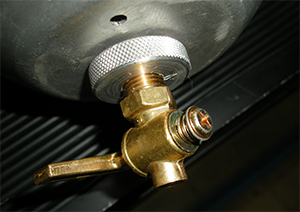 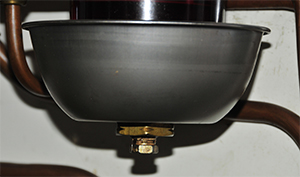 |
|
The valve on the left lacks ABYC compliance with its spring tension seat; the setup on the right uses a drain plug, not a valve. |
Tandem co-mounted MAX series filters are available, which essentially allow the user to draw fuel through one of two filters at a time, keeping one fresh, clean filter in reserve. If the selector valve of the MAX series filter is placed in the 12 o’clock position then fuel will be drawn through both filters, but this setting affords no backup capability and is not recommended. If the pointer on the selector valve is placed in the 6 o’clock position, all fuel flow is shut off, which may be useful during element replacement. If one filter should become clogged, simply swing the selector valve through 180 degrees — from 3 o’clock to 9 o’clock, or vice versa — and you’re operating on a clean filter, provided it’s been serviced.
The peace of mind afforded by the tandem “ready in reserve” primary filter arrangement is incalculable; you simply don’t have to worry about replacing a primary filter element while underway again.
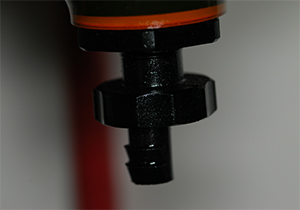 |
|
Plastic valves also lack ABYC compliance. |
Water and vacuum
The addition of an optional water sensor to the primary filter will alert the operator to the presence of water within the filter bowl long before it reaches the filter element. Placing this sensor’s annunciator at the helm or nav station means the operator doesn’t have to climb into the engine room to check for accumulated water within the filter’s bowl. The sensor itself should be tested annually, as the contacts can corrode if immersed in water.
While you can check for water in a filter’s bowl at any time underway or at rest, accurate vacuum readings can only be taken while the engine is under load. Once you throttle back, the vacuum inevitably falls. The solution is to remotely mount the vacuum gauge at the helm (runs over 10 feet should be plumbed with metallic tubing and all plumbing must meet the same rigorous ABYC guidelines established for fuel lines, including flame resistance), or to install a recording drag needle-equipped gauge at the filter body. The former can be glanced at any time while the vessel is underway, while the recording gauge will retain a record of the highest vacuum reading experienced until it is reset; it can be checked at any time.
Although it varies from engine manufacturer to engine manufacturer, most marine diesels will tolerate a vacuum as high as 10 inches of mercury. Gear lift pumps, found on larger engines, are more tolerant of high vacuum than the more common diaphragm pumps. Although no amount of vacuum is good — and lower is always better — this is roughly the high threshold for safe engine operation. Check your engine’s specifications to determine the maximum recommended vacuum. High vacuum can lead to fuel starvation, high fuel temperature, erratic fuel timing, shortened lift pump life, cavitation erosion within injection pumps, poor performance and ultimately engine shutdown.
The vacuum gauge, rather than the calendar or engine hour meter, should be the key indicator of primary filter element replacement.
Size matters
Because they are rarely supplied with an engine, it’s important that primary fuel filters be properly selected by boatbuilders, boatyards and do-it-yourselfers — in many cases, they are not. Many users are under the impression that the amount of fuel an engine uses determines the specified flow rate of the filter. In fact, it’s a function of the amount of fuel an engine pumps, which is nearly always considerably greater than the amount of fuel it actually consumes (diesel engines pump more fuel than they use, returning the unused fuel to the tank in order to cool the fuel injection components). To complicate matters, high-pressure common rail engines tend to pump much larger quantities of fuel, often twice as much, than their conventionally injected cousins. Thus, a vessel equipped with a conventional 400-hp engine may use a Racor 500 series filter, which has a flow rate of 60 gallons per hour, while the common rail version of the same engine may require a 900 series filter with flow rate of 90 gallons per hour.
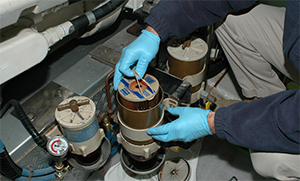 |
|
It may be necessary to replace a filter in a hurry, which means the process should be relatively quick and easy and not require any tools. |
Which micron rating?
The question is often asked, which micron rating filter element should I use in my primary filter: 2, 10 or 30? Engine and filter manufacturers are in near-universal agreement, although not always for the same reason, that the primary filter should be either 30 or 10 microns (some engine manufacturers specifically call out one or the other, check your specifications). Some users are adamant about using only 2 micron elements in their primary filter bodies. In some cases, their adamancy for this approach reaches near-religious fervor, and it goes something like this: Why should I change two filters when I can change only one? If all the debris gets captured by the primary — and, by the way, it’s usually much easier to change and less expensive — why even rely on the secondary filter [on the engine] for anything other than backup?
Here’s my position. The average 2-micron secondary filter is especially efficient at capturing millions of fine particles until called upon to also capture larger gravel-sized particles as well. The reason for this is straightforward; in spite of their absolute-sounding ratings of 2, 10 and 30 microns, these filters do not possess an absolute ability to capture all particles of their respective ratings and larger. Some larger-sized dirt inevitably slips through. However, because of a phenomenon known as micro-caking, as the filter begins to capture some contaminants, it becomes more efficient at capturing more of the smaller particles — the dirt actually becomes part of the filtering process. If, however, both large and small particles are included in the mix, then the micro-caking process is hindered; the larger “gravel” leaves holes in the caked surface layer, allowing some debris to pass through the (secondary) filter. Picture a bucket with a few holes placed in the bottom; if you pour fine sand into the bucket, some of the sand will filter through the holes, but eventually the sand will capture more new sand than is filtering through the holes. If, however, you poured a mixture of fine sand and gravel into the same bucket, the gravel would keep pathways open for the sand to continue to filter through to the holes in the bottom.
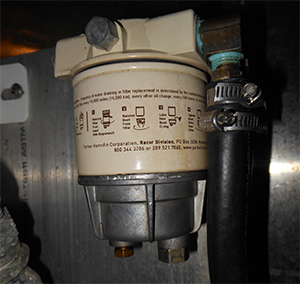 |
|
Most primary filter models are available in ABYC-compliant configuration. However, in some cases it means forfeiting the see-through bowl because no flame shield is available. |
Additionally, operating a 2-micron element as the primary filter means, in theory, all or most of the contamination will be captured in this element and virtually nothing will be captured by the secondary on-engine filter. Thus, you’ve effectively halved your filter media surface area — you now have only one filter that must contend with all of the contamination. If you should happen to take on a batch of particularly dirty fuel, this primary filter may quickly become overwhelmed. If, on the other hand, your primary filter is a 30- or 10-micron rating, then the contamination can be divided between the two filters, offering greater overall media surface area with the finer filter because of the lack of large particles, operating more efficiently to boot. While anecdotal evidence may suggest that 2-micron primary filtration works, this is likely more so the case when dealing with relatively clean fuel. Once comparatively dirty fuel is encountered, segregating the contamination into two locations is simply more efficient and desirable.
Some will argue that the MA Turbine series filters are overkill on smaller sail auxiliaries and gensets. But smaller filters not of the Turbine series lack too many of the attributes, including the large water-holding capacity, clear bowl, coalescing cone and turbine, ease of service and bleeding, and water sensor among others. None of the smaller primary filters I’m aware of can be equipped with a clear bowl — all must use a metallic bowl rather than heat shield to achieve flame resistance.
Having changed hundreds of primary fuel filters, I can attest to the value of Turbine series filters, even if they do represent an element of overkill. Where fuel filtration is concerned, overkill is good.
Steve D’Antonio is an ABYC master technician (stevedmarineconsulting.com).

